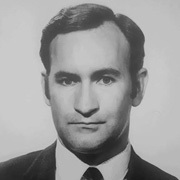
Doug Eckhoff
Douglas Napier Eckhoff was born in Dunedin on 5 February 1937, and spent much of his childhood in Central Otago. After leaving Otago Boys' High School, he worked as a reporter for The Otago Daily Times and The Clutha Leader.
For his big OE, Eckhoff travelled to the United Kingdom, finding newspaper work there as a sub-editor.
On his return in 1962 Eckhoff joined the NZ Broadcasting Corporation in Wellington. Television, still in its infancy and striving to establish a news service, offered opportunities for keen journalists willing to start from scratch and learn as they went. Looking back some 30 years later in a Listener article promoting documentary Here is the News, Eckhoff gave a daunting litany of equipment that was lacking at the beginning, but recalled his team’s enthusiasm for the task.
Aside from news from overseas sources, each of the four regional channels had cameramen filming news items of local interest. In Wellington, Channel 1 (or WNTV-1) made use of National Film Unit cameramen for news assignments, until it was able to build up its own staff. Items of national interest had to be copied, for dispatch to stations elsewhere.
Eckhoff was proud to have played a part in leading the news team which won a World Newsfilm award in 1968, for their coverage of the Wahine disaster. It was an event of national interest seen only by viewers of WNTV-1 on the actual day, networking of the four regional channels still being a long way off.
Making do with available resources was occasionally aided by ingenuity and clever planning. The cooperation of the RNZAF and the setting up of a temporary microwave link meant that a videotape of the first moon landing, especially recorded and flown in from Australia, could be telecast nationwide only hours after the event.
From February 1970, with the permanent microwave link in place, the network news was transmitted on a regular basis at the earlier time of 7pm. As duty editor for the network news, Eckhoff was in charge of minute to minute operations, alternating in this role with Lindsay Shelton. The two had different styles — Eckhoff was described as “cool and firmly in charge, hating to be pinned down by rules”. Shelton recalls that both resisted "very occasional" pressure from the government to cut back on coverage of the Vietnam War. The programme consistently received top ratings.
The establishment of a second network in 1975 brought competition from South Pacific Television with its own news coverage. Later, when the erstwhile competing channels were merged to form Television New Zealand, Eckhoff decided it was time to move on. In 1980 he successfully applied for the job of Manager of the National Film Unit, recently vacated by David Fowler for health reasons.
Having just moved into new premises in Lower Hutt — which included a soundstage and viewing theatres — the NFU had some teething problems with its laboratory. At a time when production of New Zealand movies was expanding, the expensive new facilities had to overcome unwanted negative publicity to operate on a commercial basis. Keeping up with advances in technology demanded new equipment — including modular printers for the laboratory, and a suite for Dolby Stereo sound mixing — facilities which benefitted the whole screen industry.
Aside from the NFU's own films (e.g. Oscar nominee The Frog, the Dog and the Devil), independent productions continued to go through the Unit's laboratories in this period. Among them were Bad Blood and Gaylene Preston's debut feature Mr Wrong. The NFU also invested in The Scarecrow, directed by ex staffmember Sam Pillsbury.
Some discontent arose among NFU staff as the films being made by the unit declined in number. The discontent turned to anguish with the announcement that the unit would be sold. Eckhoff and a group of colleagues made a bid to purchase the NFU, but it was unsuccessful.
Following the sale of the NFU in 1990 Eckhoff was briefly a consultant to the Avalon TV Centre, before joining the Department of Justice to manage its communications unit.
Back when the New Zealand Film Archive (now Ngā Taonga) was set up in 1981, Eckhoff, as NFU Manager, became one of the trustees. Continuing as a trustee for 25 years, Eckhoff received a 2007 Taiki Ngapara award for his service on the Board and as president of the group established by the bicultural constitution of the Film Archive in 1999.
He was further recognised in the 2010 Queen’s Birthday Honours, being made a Member of the New Zealand Order of Merit for services to film.
Doug Eckhoff died on 20 July 2012, at the age of 75.
Published on 30 May 2019
Sources include
Lindsay Shelton
Douglas Eckhoff, ‘Birth of a News Service’ - The Listener, October 31, 1992, page 5 (volume 135, number 2744)
Here is the News (Television Documentary) Director Carol Hirschfeld (TV One, 1992)
Jane Clifton, ‘Umpiring between artist, taxpayer’ - The Dominion, 6 October, 1980, page 4
Patrick Day, Voice and Vision – A History of Broadcasting in New Zealand, Volume Two (Auckland University Press, in association with the Broadcasting History Trust, 2000)
Irene Gardiner, ‘Film unit draws negative comments’ - The Dominion, 27 October, 1982, page 9
Shani Naylor, ‘Making the film unit work like clockwork’ - The Evening Post, 31 December 1987, page 10
Rosemary Vincent, ‘National Film Unit allays staff fears’ - The New Zealand Times, 22 April 1984, page 4
Pauline Swain, ‘The story behind the network news’, - The Listener, 26 June 1972, page 6 (volume 70 number 1703)
Unknown writer, ‘How Television Newsreel is Made’ - The Listener, 31 May 1963, page 15 (volume 48 number 1234)
Unknown writer, ‘Movie-makers keen to use LH studios’ - The Hutt News, 9 June 1981, page 1
Unknown writer, ‘Taiki Ngapara’ - Newsreel 56, Summer 2007